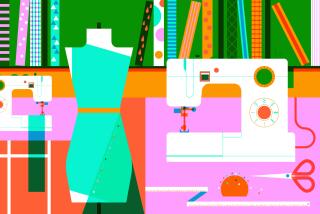New Tools Make It Easier
- Share via
Home sewing may be appealing, but who has the time? That is a big question for many people busy with jobs and children.
“It never ceases to amaze me that even (experienced sewers) aren’t aware of what the new machines can do,” said Suzanne E. Sillence Haines, director of marketing communications for 133-year-old Singer Sewing Co.
One reason for the new vigor in the home sewing market is the growing popularity of home machines that have the speed and capability of professional models. Particularly popular are auxiliary sewing machines known as sergers or overlocks, which quickly sew, fortify and trim seams in one operation.
Such machines, sold by various companies under brand names such as Baby lock, Superlock, Ultralock and Elna Lock, have been available to consumers for 21 years, said sewing consultant Jody Nickel, but little marketing of them was done until about seven years ago when Juki Co. introduced Baby lock. “It was a product that just sat on the shelf,” she said.
Sergers, often said to have done for home sewing what the microwave did for cooking, make it easier to sew knits and to make lace trims and attach sequins and pearls for evening and bridal wear. The machines retail from about $499 to $899, Nickel said. All are made in Japan, she said, although some consumers have been misled into paying more for a European brand name.
However, sergers aren’t a replacement for regular machines necessary for such tasks as installing zippers and top stitching. New electronic and computerized regular machines are also faster and easier to use, Haines said. Features once only available in expensive machines are now available for much more moderate prices, she added, describing machines that sew sideways, automatically embroider and quickly create monograms.
“We have machines that remember the size of a button and automatically recreate the exact size buttonhole with a touch,” she said.

